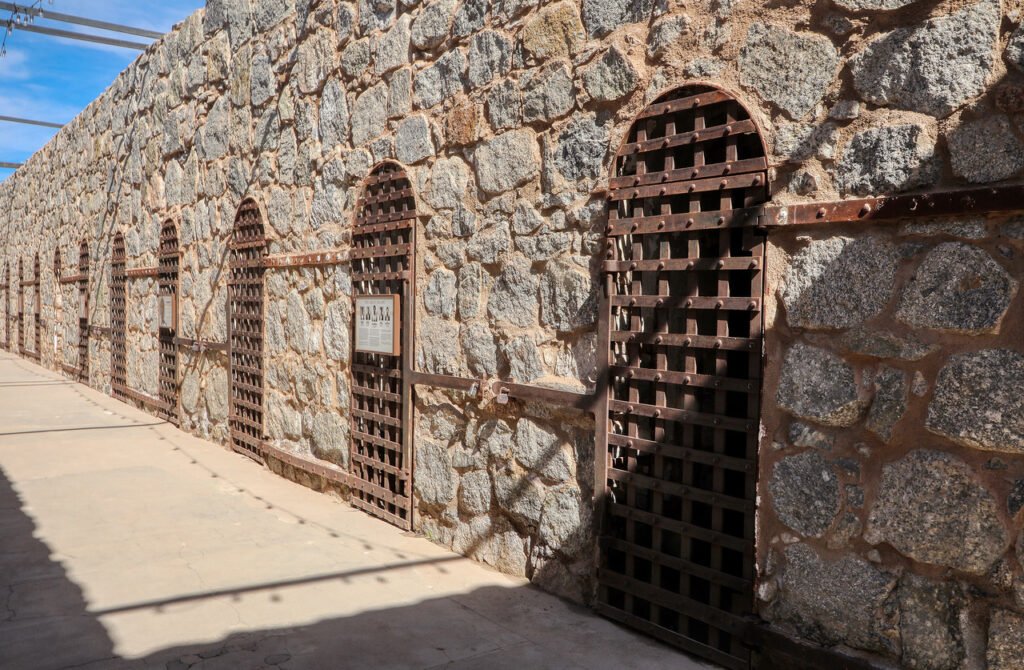 Prison Cells: A row of cells in the Yuma Territorial Prison cell block shows crossed steel bands on every cell door and entrance to the cell block. Photo credit: Gary Warren/ladailypost.com
Prison Cells: A row of cells in the Yuma Territorial Prison cell block shows crossed steel bands on every cell door and entrance to the cell block. Photo credit: Gary Warren/ladailypost.com

 Cell Block: The exterior of the cells in the cell block reveals the massive walls of the Yuma Territorial Prison cells. During his 33 years in operation, the prison housed more than 3,000 criminals. The prison was closed in 1909 due to overcrowding and the lack of space to expand on the bluff where the facility was located. Photo credit: Gary Warren/ladailypost.com
Cell Block: The exterior of the cells in the cell block reveals the massive walls of the Yuma Territorial Prison cells. During his 33 years in operation, the prison housed more than 3,000 criminals. The prison was closed in 1909 due to overcrowding and the lack of space to expand on the bluff where the facility was located. Photo credit: Gary Warren/ladailypost.com
Written by Gary Warren
photographer
Formerly from Los Alamos
Perched atop granite bluffs overlooking the Colorado River, you can peer into the prison cells occupied by Wild West lawbreakers more than 100 years ago. There's a reason the western United States was called the “Wild West” in the 19th century.
Yuma, Arizona was incorporated as Arizona City in 1871. In 1873 the name was changed to Yuma. The need for a prison led to the construction of the Yuma Territorial Penitentiary from 1875 to 1876. Inmates held at the Yuma City Jail were transported approximately three miles to the construction site of the new prison, where they worked as laborers to help build the new prison.
On July 1, 1876, the first seven prisoners moved into the Yuma Territorial Penitentiary, which they helped build. Although the area was not yet a state, it was a territory of the United States at the time of the prison's construction and opening. The area remained a territory until 1912, when the state of Arizona was admitted to the United States.
Yuma Territorial Prison housed prisoners who committed crimes ranging from theft to murder. One of the famous prisoners was the legendary stagecoach robber Pearl Hart. Over 3,000 criminals have served time in prison over the history of the prison.
One independent cell within a cell block was known as a “dark cell.” While in prison, prisoners spent time in dark cells for fighting, gambling, and other illegal activities. The dark cells were carved into the hillside and never saw the light of day. It was pitch dark. The amount of time a person was kept in a dark cell depended on the crime and could last several days or weeks.
The Yuma Territorial Prison operated for 33 years before it was closed due to overcrowding and no room for expansion on the bluff where the prison was located. In 1909, all prisoners were transferred to a new, larger prison in Florence, Arizona, and the Yuma Territorial Penitentiary was closed.
A fire destroyed Yuma High School in 1910, and the school moved to the former prison site from 1910 to 1914. The high school adopted the name “Criminal” and is still known as “Proud Criminal Yuma High School.” County Hospital he used this facility from 1914 to 1923. In 1924 the Southern Pacific Railroad added a new line and more than a third of the prison was destroyed to make way for the railroad.
In the 1930s, residents and the city of Yuma constructed a museum building on the site of the old prison cafeteria. The museum features many photographs and artifacts from the Yuma Territorial Prison era. The city operated the museum until 1960, when ownership was transferred to the state of Arizona and the site became the Yuma Area Prison State Historical Park.
Today, the West is much calmer, but looking into the cell blocks of the Yuma Territorial Prison takes visitors back in history to a more tumultuous and volatile time in the Wild West. A visit to this historic prison allows visitors to learn about life in the Wild West and what it was like to be a prisoner during historical times.
Editor's Note: Longtime Los Alamos photographer Gary Warren and his wife, Marilyn, travel the country and are featured in the “Posts from the Streets” series published in Sunday's Los Alamos Daily Post. Share your photos.

 Museum: The museum building was constructed by the City of Yuma in the 1930s on the site of the former Yuma Regional Jail cafeteria. The museum displays many photographs and artifacts from the prison era. There is also a theater showing videos of the prison's history. The city operated a museum on this site until it became a state historic park in 1960. Photo credit: Gary Warren/ladailypost.com
Museum: The museum building was constructed by the City of Yuma in the 1930s on the site of the former Yuma Regional Jail cafeteria. The museum displays many photographs and artifacts from the prison era. There is also a theater showing videos of the prison's history. The city operated a museum on this site until it became a state historic park in 1960. Photo credit: Gary Warren/ladailypost.com

 Viewing History: Visitors to Yuma Territorial Prison view history while peering into the prison cells. Huge steel doors throughout the cell blocks made escape attempts extremely difficult. Photo credit: Gary Warren/ladailypost.com
Viewing History: Visitors to Yuma Territorial Prison view history while peering into the prison cells. Huge steel doors throughout the cell blocks made escape attempts extremely difficult. Photo credit: Gary Warren/ladailypost.com

 Bedrooms: Prisoners slept in cells with three bunk beds on each wall, or six prisoners per cell. Steel beds are clearly not made for comfort. Photo credit: Gary Warren/ladailypost.com
Bedrooms: Prisoners slept in cells with three bunk beds on each wall, or six prisoners per cell. Steel beds are clearly not made for comfort. Photo credit: Gary Warren/ladailypost.com

 Watchtower: The prison's watchtower overlooked the Colorado River and the land beyond from its vantage point on the cliff where the prison was located. The tower also had a view of the prison, which was surrounded by high adobe walls. Photo credit: Gary Warren/ladailypost.com
Watchtower: The prison's watchtower overlooked the Colorado River and the land beyond from its vantage point on the cliff where the prison was located. The tower also had a view of the prison, which was surrounded by high adobe walls. Photo credit: Gary Warren/ladailypost.com
















